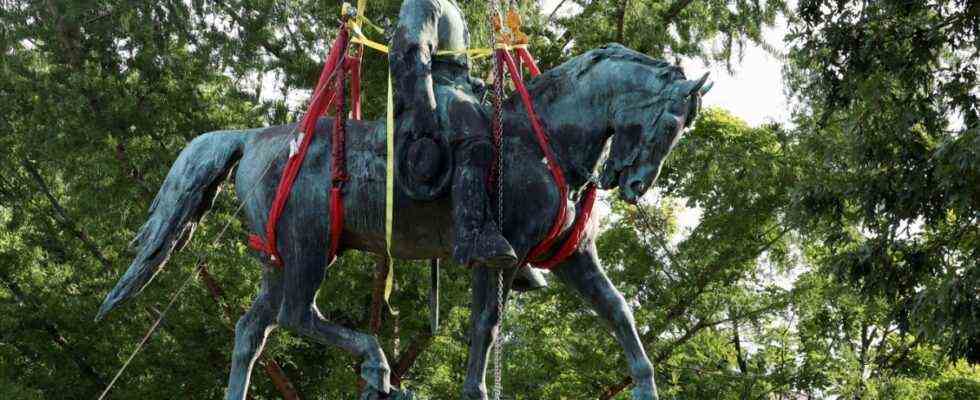One of the most famous monuments of the American South is disappearing: the statue of Robert E. Lee in the middle of Charlottesville. It started with a harmless school project, then the city became a terrifying example of how strong right-wing extremist movements are in the United States. As part of her class work, the student Zyahna Bryant started a petition in 2016 demanding the removal of the bronze sculpture of the southern general. The petition quickly gained a lot of support. Lee is one of the symbols of the racist past of the southern states: he led the Confederate troops that fought to keep slavery in the American Civil War.
There are still several images of Lee in the southern United States. His sculpture in a central location in Charlottesville, however, had a special meaning: It became a national symbol in the culture war between conservative southerners and the rest of the United States after the city voted for its removal. In 2017, thousands of neo-Nazis streamed into the city to demonstrate against the decision under the slogan “Unite the Right”. The torchlight procession ended in violence; a young woman was killed when a right-wing extremist drove his car into a group of counter-demonstrators. A few days ago the organizers of the march were sentenced to pay millions in compensation.
The racists were initially able to delay the dismantling of Lee, but not prevent it. In July, the sculpture, which weighed more than half a ton, was dismantled and stored in a visually powerful action. This was also the case with another bronze portrait showing Thomas Jonathan “Stonewall” Jackson, the second most famous general in the southern states.
Now the Charlottesville City Council has decided to donate the Lee statue to a local museum, the Jefferson School African American Heritage Center. Around a dozen applicants were interested in the monument, and they wanted to pay up to $ 50,000 for it. Most planned to add the statue to their Southern Monuments collection.
The new plant should be ready in 2027
The museum, which has now been awarded the contract, will melt down the statue under the biblical motto “Swords into plowshares” – destructive weapons become a tool that nourishes, promotes fertility and life. “What once poisoned our public space, we transform into something beautiful that better reflects our values,” says museum director Andrea Douglas in a video that the museum is now using to raise money.
So far it is only clear that a foundry will melt down Lee and initially pile it up as bronze ingots in a corner. The museum and a number of partner organizations want to work out with the population first what exactly will become of it later. “Our community will meet white racism with creativity and heal the ugliness of the past with beauty,” the video reads. The project is expected to cost 1.1 million dollars, around half of which has been secured, and an appeal for donations is running on the Internet for the rest.
On the 100th anniversary of the statue’s erection, a jury is to commission an artist to create a new work in 2024. It is to be inaugurated in 2027, on the 10th anniversary of the summer of hatred in 2017. The schedule is ambitious, especially since everything takes place under strict security precautions: The initiators do not want to risk the dispute over the statue leading to violence again.
100 monuments were dismantled last year
The Lee statues are defended by some southerners as their cultural heritage. The Charlottesville Monument, like many others, was not erected until years after the Civil War, in 1924. The gift from Paul Goodloe McIntire, a white stock trader, is a typical example of how whites were in those years of the Ku Klux Klan and racist laws took the public space for themselves.
How to deal with the monuments has been heatedly debated in the USA. The trend is clear: in 2020 nearly 100 Confederate monuments were dismantled in the United States. It wasn’t until September that the largest Lee statue in the south, in Virginia’s capital, Richmond, had to be taken down from its pedestal. It had become the focus of demonstrations after the murder of the African American George Floyd. Now the 12-ton piece is in a warehouse, its future is unclear.
The initiators of the project in Charlottesville hope that their art campaign will inspire other localities to remove and rededicate their southern monuments as well.

